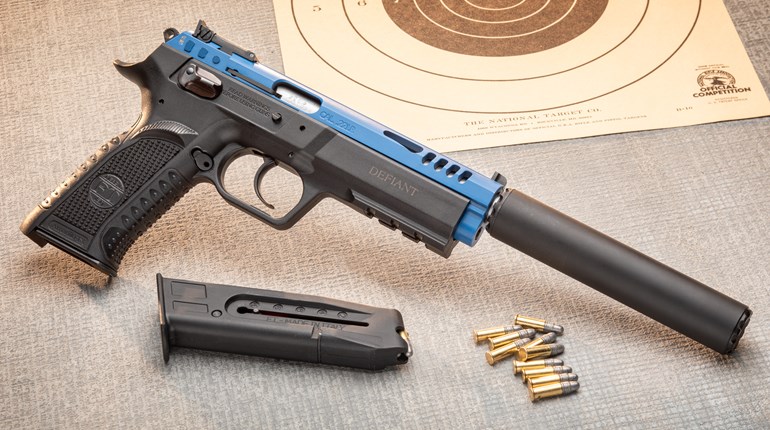
Magazine Base Pads
If you follow A1F’s “Carry Life” column, you will know we’ve been on a bit of a tear lately regarding magazines for semi-automatic pistols. The rationale is straightforward: Through long and unpleasant experience—extensively observed, as well as our own—we’ve learned what a high percentage of reliability issues are actually magazine-sourced.
Here and here, we talked in some detail about preventive and/or precautionary measures. We wouldn’t suggest these are unique thoughts, just collected for your benefit. You can easily determine they’ve been vetted and repeated by high-round-count shooters in many venues. But in terms of “First Gear” ramifications, all depend on a small but crucial detail—the ability to differentiate one magazine from another.
As a major “duh,” this has few equals: Of course you’d only take the single offender out of service until it could be repaired or retired. The difficulty appears in the way mags actually fail—intermittently, at least at first. Those occasional hiccups, especially for the hand-loader trying to achieve very specific, edge-of-the-envelope performance, are a fact of life. But precise tracing of failures is only possible if all the variables can be tracked. Which magazine was in the gun when a problem occurred could wind up being the key piece of any such data. Think of restored (or perfected) reliability as science, not snipe-hunt.
We grant, however, it’s not necessarily rocket science. But that said, it’s an opportunity to bag multiple birds with a single stone, and that brings us to bases designed by USPSA Grand Master Henning Wallgren and available through his HenningShop.
Magazine Differentiation
This is “Job 1,” as the saying goes: Make magazines uniquely identifiable. When trouble comes, you’ll want—need?—to be able to systematically eliminate variations, and Production Base Pads make this about as easy as possible. Currently available for small frame Glocks, Smith & Wesson M&Ps, Tanfoglio/CZ-75 (small and large frame), Grand Power X-Calibur, K and P series pistols, and the SIG 320, these are single pieces of sculptured aluminum that provide for two differentiation schemes. (Springfield XD owners, do not lament: Yours are on the way.)

If the number of magazines you have is relatively small (an idea we don’t encourage—three is what we’d call an absolute minimum), you can simply rely on color. Most of the Prod BPs are available in four different anodizations—black, silver, red and blue. If you wisely have larger complements, you can use the color to differentiate between models. Our schema, for instance, uses blue for G17, black for G19.
Differentiation within the models is easy, too, albeit more subtle. Take a look at our photo, and you’ll see dimples in the bases. These provide a second level of marking and discrimination limited only by the imagination. A dab (or seven) of Mrs. Guns & Gear Editor’s nail polish is a durable, high-visibility, rewritable favorite, and gives us an eight count, but we trust you to puzzle this out as suits your own needs. More than eight mags? Mark from both ends, or use two (or more) colors in the dimples.
Another slick feature of these is easily overlooked, so we’ll point it out: The Production Base Pads add not quite four times the mass to your magazine over the standard base plate (in Glock pistols, anyway), and that contributes useful “drop-free” impetus to any speed reload.
Lots of options, as we said.

Add Round Count
Bases are also a great way to add round count, particularly to carry pistols. You’ve already seen a favorite here, and it too comes from HenningShop in the form of the BlueLine extensions. Even if they didn’t add round count (+4 in 9 mm and .40/10 mm, +3 in .45 ACP), these would still be particular favorites of ours. On G26- and G27-sized pistols especially, the forward-projecting lobes provide useful up-pressure on the otherwise dangling little finger, to say nothing of perfect finger position indexing for the initial grab from the mag holder. Until you do your own “with” vs. “without” test, it’s hard to appreciate how much they improve grip and overall control of the sub-compacts once they’re in the pistol. They also facilitate ultra-positive stripping of the magazine by “blading” the weak hand downward on mag removal. With a little practice, the extra purchase is even sufficient to clear a Type III malfunction without locking the slide to the rear.

EDC (Every Day Carry) grip extensions are a subtler combination of the Production Base Plates and BlueLine functionality. On smaller-framed guns, that dangling pinky will still be supported, but in about half the vertical height. Round count add is two, and a whopping six different colors make the magazine differentiation part of the puzzle a no-brainer (no dimples, though).
Small single-stack pistols benefit from HenningShop kit too, at least the Glock 43 (9 mm) does. One of the newest base pad designs, these take the outstanding deep-cover 9 mm to an 8+1 round count, and give full support to the pinky. While we’ve found the slim line models astonishingly precise at distance, this just gets better with the G43 EDC pads. We’ve been using variations on these since they were first available—from other manufacturers, that is—and we close with a shameless endorsement: Don’t waste your time. Others may be slightly cheaper, but Henning’s are waaaaay better.
Visit HenningShop LLC at www.henningshop.com.

































